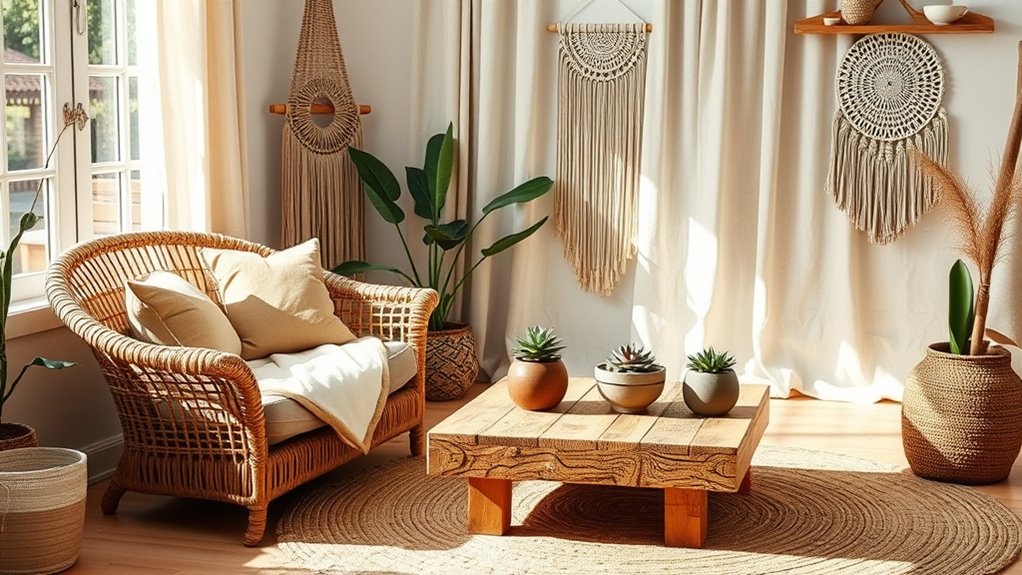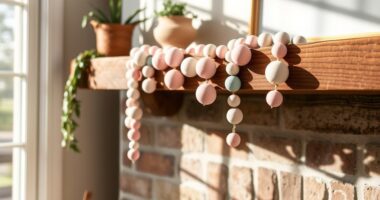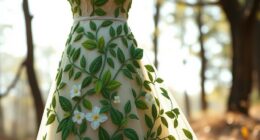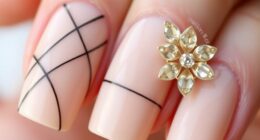To create eco-friendly boho decor, focus on natural, sustainable materials like rattan, jute, linen, and bamboo, which age beautifully and support waste reduction. Choose brands committed to ethical sourcing, fair trade, and transparency, such as The Citizenry, West Elm, or Lorena Canals. Incorporate reclaimed or vintage furniture and textiles, and support artisans using eco-friendly dyes. Exploring these options helps you design a charming, responsible space—discover more ways to make your boho vibe truly sustainable.
Key Takeaways
- Prioritize natural, renewable materials like rattan, seagrass, bamboo, and organic textiles to create eco-friendly boho spaces.
- Support ethical brands with fair trade practices, certifications (GOTS, OEKO-TEX®, FSC), and transparent supply chains.
- Incorporate reclaimed, vintage, and upcycled decor to reduce waste and add authentic charm.
- Choose textiles and crafts made from eco-conscious fibers, natural dyes, and handcrafted by artisans.
- Opt for furniture and decor with environmentally responsible finishes, biodegradable packaging, and responsible sourcing.
Embracing Natural Materials in Boho Spaces
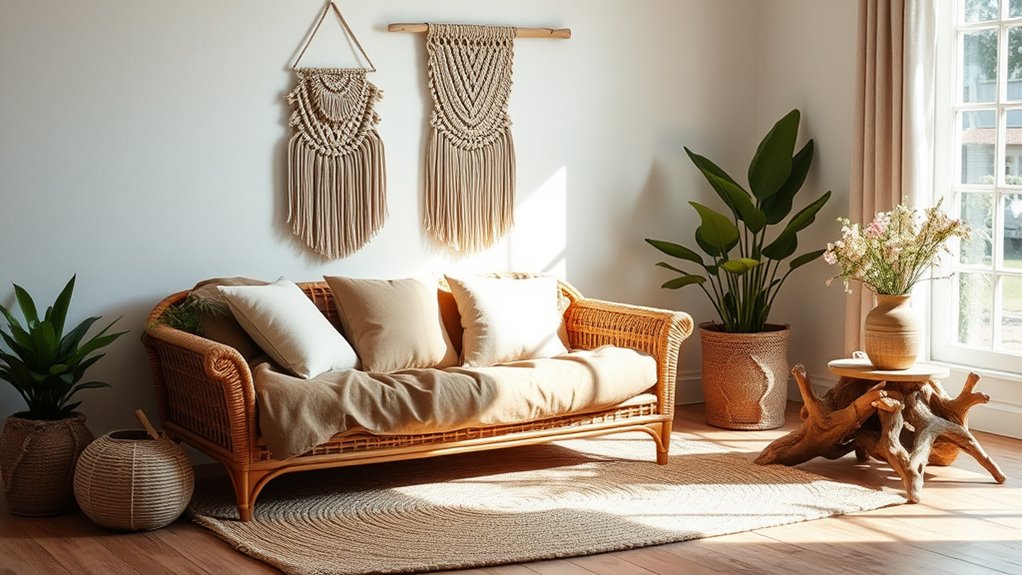
To create authentic boho spaces, you should embrace natural materials like rattan, seagrass, bamboo, and water hyacinth, which provide both durability and eco-friendliness. These materials are essential to sustainable design, helping you craft a space that’s stylish and responsible. When choosing natural materials, prioritize ethically sourced options to support fair labor practices and local artisans. Handcrafted, natural fiber textiles like jute rugs and linen cushions add tactile richness and enhance your boho aesthetic. Over time, these materials age beautifully, developing character and warmth that make your space feel cozy and lived-in. Incorporating natural materials not only strengthens your design’s authenticity but also reduces environmental impact, making your decor both beautiful and sustainable. Sustainable materials are a cornerstone of eco-friendly boho decor, ensuring your space remains environmentally conscious while maintaining aesthetic appeal. Additionally, selecting ethically sourced materials helps promote fair trade and supports sustainable communities.
Top Ethical Brands for Eco-Conscious Decor
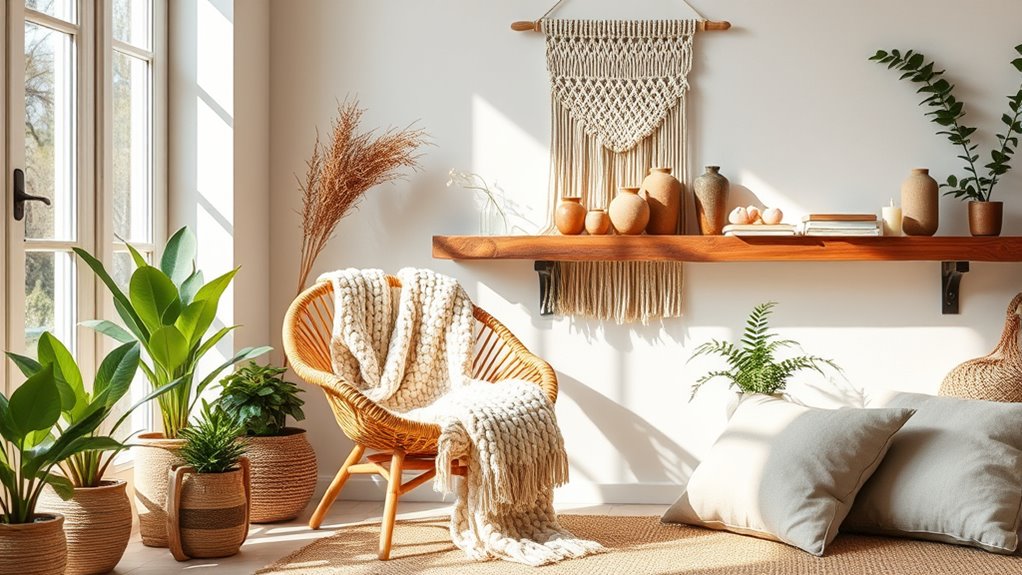
If you’re seeking eco-conscious decor, choosing brands that prioritize ethical practices is essential. Ethical brands like The Citizenry, West Elm, and Woven focus on fair trade practices, artisanal craftsmanship, and the use of sustainable materials such as FSC-certified wood, organic textiles, and recycled fibers. Many of these brands hold certifications like GOTS, OEKO-TEX®, FSC, and B Corp, ensuring their products meet strict environmental and social standards. Woman-owned and small business brands like Lorena Canals, House of Leon, and Reformation emphasize ethical sourcing, fair wages, and support for local artisan communities. Eco-conscious brands often incorporate biodegradable packaging, transparent supply chains, and eco-friendly dyes. Additionally, some brands are aware of the importance of sustainable material choices to minimize their environmental footprint, and they often collaborate with artisans to promote ethical craftsmanship. Incorporating sustainable materials into decor can also help reduce waste and support environmentally friendly practices. Using transparent supply chains allows consumers to make informed decisions and promotes accountability within the industry. Many brands also prioritize eco-friendly packaging to further lessen their environmental impact. Platforms like Made Trade and Mercado Collective curate collections from these ethical brands, making sustainable, beautifully crafted decor accessible for your boho home.
Incorporating Reclaimed and Upcycled Elements
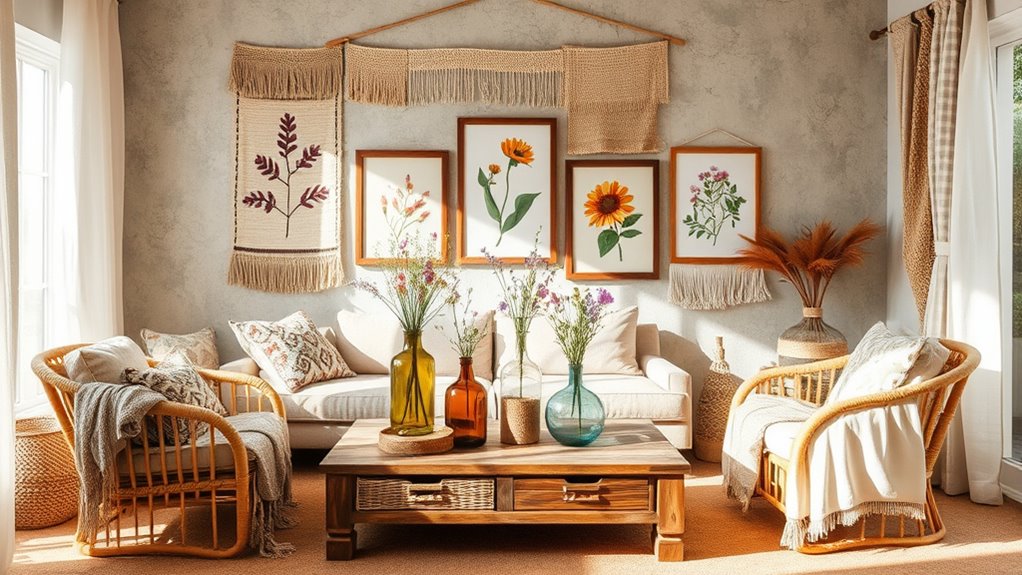
Incorporating reclaimed and upcycled elements into your boho decor not only adds unique character but also supports sustainability. By choosing vintage furniture or repurposed textiles, you reduce waste and give new life to materials that would otherwise be discarded. Brands like Dilli Grey and Christy Dawn focus on upcycled fabrics and recycled materials, highlighting circular fashion principles. Using reclaimed wood for furniture supports sustainable forestry and prevents deforestation. Upcycled decor, such as vintage glassware or reclaimed metal art, brings authenticity and charm to your space. Emphasizing body awareness and mindful choices in decorating can deepen your connection to the environment and promote a more eco-conscious lifestyle. Incorporating sustainable materials can further enhance your eco-friendly decor efforts. Additionally, selecting materials with a low environmental impact ensures your design choices align with eco-conscious values. Below is a quick overview of common reclaimed and upcycled materials: | Material | Source | Impact | |—————–|—————————-|————————————————-| | Reclaimed wood | Old furniture, barns | Supports sustainable forestry | | Upcycled textiles | Vintage fabrics, scraps | Reduces textile waste, adds unique texture | | Reclaimed metal | Discarded industrial pieces | Creates one-of-a-kind art and accents | A focus on material reuse encourages a more eco-conscious approach to interior design.
Sustainable Textiles and Crafts for a Cozy Vibe
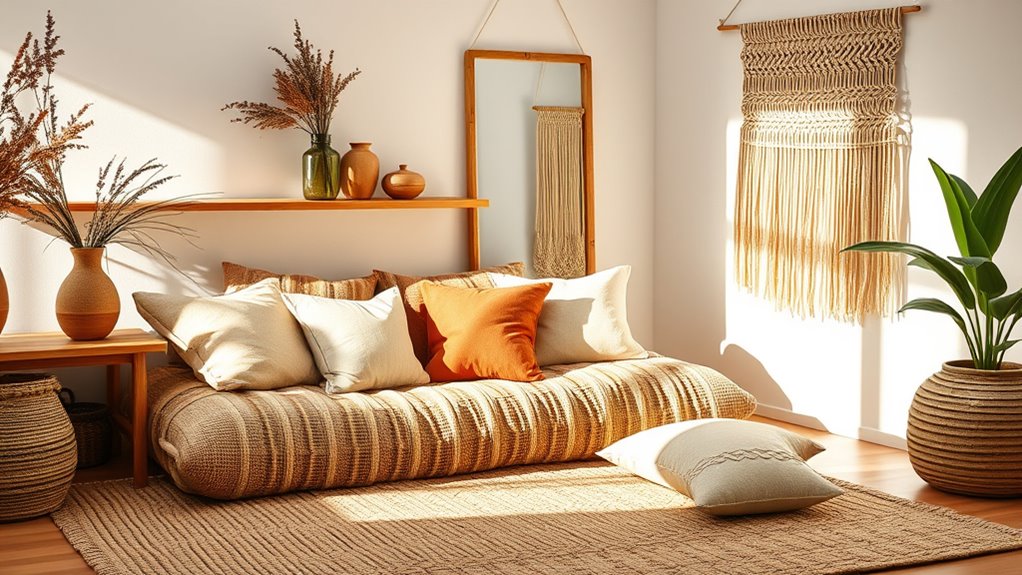
Sustainable textiles like organic cotton, linen, and hemp offer a safe and eco-friendly way to add warmth and texture to your boho decor. These materials are produced without harmful chemicals, improving indoor air quality and reducing environmental impact. Incorporate handwoven crafts from natural fibers like jute, seagrass, and raffia to add tactile interest and support traditional artisans. Many of these textiles are dyed with eco-friendly dyes derived from plants, ensuring vibrant colors without toxic chemicals. Textured textiles, such as macramé wall hangings and braided cushions, create a cozy layered look that emphasizes natural, sustainable materials. Choosing sustainable materials not only enhances your decor but also promotes responsible consumption and environmental stewardship. Selecting textiles made from eco-friendly fibers aligns with a conscious lifestyle and encourages sustainable practices. Supporting brands that prioritize ethical production ensures that artisans are compensated fairly and that environmental standards are maintained. Incorporating sustainable textiles can also inspire eco-conscious habits in daily living and decorating choices. Using certified eco-friendly fibers can further guarantee that your decor choices meet strict environmental standards. By choosing sustainable textiles and handcrafted pieces, you bring warmth, character, and eco-consciousness into your space, perfectly aligning with the boho aesthetic.
Tips for Selecting Eco-Friendly Decor Pieces
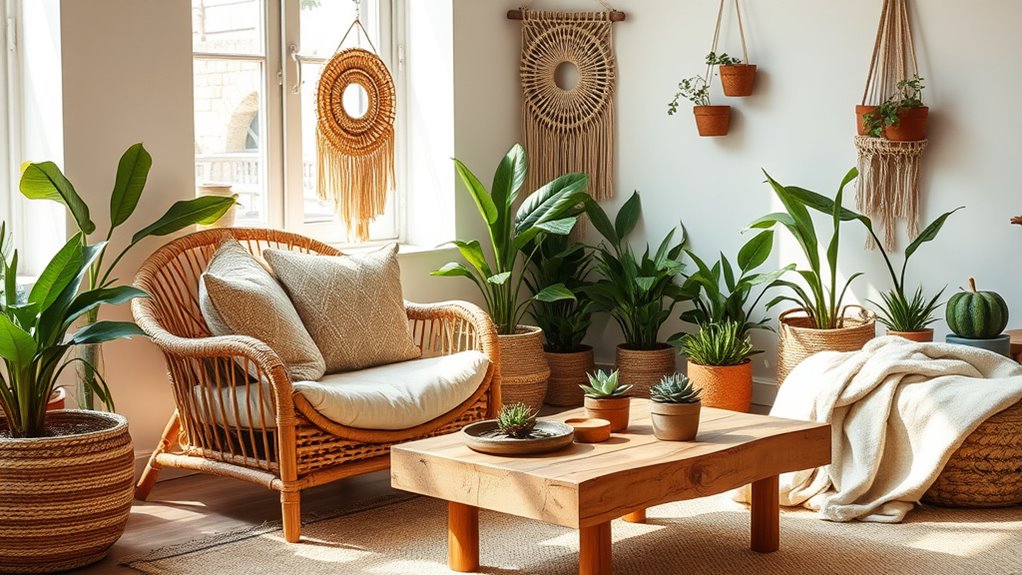
Choosing eco-friendly decor pieces allows you to enhance your boho space with natural beauty while staying mindful of the environment. Focus on items made from sustainable materials like rattan, bamboo, seagrass, or water hyacinth, which are renewable and biodegradable. Look for certifications such as GOTS, OEKO-TEX®, FSC, or Fair Trade to guarantee products meet strict environmental and social standards. Prioritize handmade items and artisanal pieces, as they support fair wages and reduce the environmental impact compared to mass-produced alternatives. Select furniture and decor with eco-friendly finishes, natural dyes, and non-toxic paints to improve indoor air quality. Supporting brands emphasizing responsible sourcing, transparent supply chains, and eco-conscious packaging, aligning your decor choices with both style and sustainability, is also beneficial for sustainable sourcing. Incorporating ethical manufacturing practices ensures that your decor supports fair labor and sustainable development. Additionally, choosing products with certifications and standards can provide extra assurance of their eco-friendly credentials. Being aware of the best modern toilet options can also contribute to eco-friendly bathroom upgrades, promoting water efficiency and sustainable fixtures. Affiliate disclosures and ensuring transparency in your purchases can also help you make more ethical and environmentally friendly choices.
Frequently Asked Questions
What Is the Best Eco-Friendly Home Decor?
When you ask about the best eco-friendly home decor, you’re looking for options that are sustainable and safe for the environment. You should choose items made from natural, renewable materials like rattan, bamboo, or seagrass. Look for brands that are transparent about their sourcing, use non-toxic finishes, and hold certifications like FSC or B Corp. This way, you support ethical practices while creating a stylish, eco-conscious space.
Which Major Furniture Company Is Making Efforts to Be More Sustainable?
You’re curious about which major furniture company is working toward sustainability. West Elm stands out by sourcing over half its wood furniture from FSC-certified or recycled materials and investing heavily in artisan communities. IKEA is also making significant strides, using renewable materials and aiming to be climate positive by 2030. Both brands actively prioritize eco-friendly practices, so you can choose furniture that aligns with your sustainability values.
Is West Elm a Sustainable Brand?
You’re wondering if West Elm is a sustainable brand. The answer is yes. They actively prioritize sustainability by sourcing over half their wood from certified forests and investing in artisan communities worldwide. Their products include organic, recycled, and natural materials, often with eco-friendly certifications. Plus, they aim for 100% sustainable sourcing by 2025 and are a certified B Corporation, showing their strong commitment to social and environmental responsibility.
What Are the Sustainable Wood Furniture Brands?
You’re curious about sustainable wood furniture brands. You’ll find options like West Elm and The Citizenry, which prioritize FSC-certified or reclaimed wood. Brands such as Fawn Design and Medley also focus on transparency and carbon reduction. Reclaimed and upcycled wood brands give discarded wood new life, helping reduce waste. These companies commit to eco-friendly practices, so you can enjoy stylish furniture while supporting responsible forestry and circular design principles.
Conclusion
By choosing eco-friendly boho decor, you’re not only creating a stylish space but also supporting sustainability. Did you know that the furniture industry accounts for nearly 20% of global waste? Opting for sustainable materials and ethical brands helps reduce this impact. Every small change, like using reclaimed wood or organic textiles, makes a difference. So, go ahead and curate a cozy, conscious home—you’re contributing to a healthier planet with every eco-friendly choice you make.

